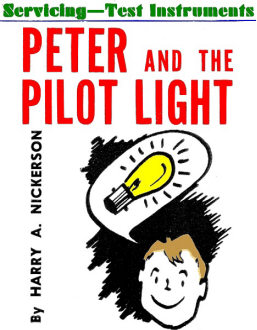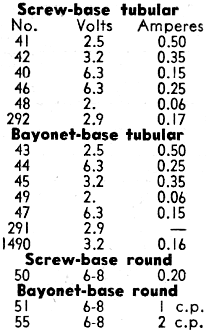|
October 1952 Radio-Electronics
 [Table of Contents] [Table of Contents]
Wax nostalgic about and learn from the history of early electronics.
See articles from Radio-Electronics,
published 1930-1988. All copyrights hereby acknowledged.
|
Incandescent pilot lights
are definitely a thing of the past; LEDs are the ubiquitous choice these days for
obvious reasons (low cost, low current, long life). Nonetheless, there is still
lots of equipment in service that do use them. In 1952 when this article appeared
in Radio-Electronics magazine, incandescent (and neon) lamps were standard
in test gear, radios, televisions, tape recorders, record players, kitchen appliances,
cars, industrial machinery, and many other everyday things. Electronics repairmen
needed to deal with them on a regular basis. Although not technically sophisticated,
knowing a little something extra about the little bulbs could be quite handy. One
tidbit if useful info in this article is how the color of the little glass bead
that mounted the filament to the base was often a clue to the current draw of the
lamp at nominal operating voltage. I have noticed the colored beads, but never knew
it had any specific significance. Note the pun at the end.
Servicing Test Instruments: Peter and the Pilot Light
 By Harry A. Nickerson By Harry A. Nickerson
That's a wreck of a heck of a set," said Peter.
Peter, is my right-hand man (or rather boy). He dusts off the chassis, makes
repairs strictly as directed, handles the screwdriver and soldering iron almost
as well as a girl set-assembler in a factory. He's also a pump, that pulls up my
radio wisdom or lack of it and sometimes stores it in his small reservoir of a brain.
"Look at the dial - there's not even a pilot light," he continued. "How would
you take care of that?"
Sure enough, there was no pilot-light socket or bulb. The set was an old a.c.-d.c.
using 0.3-amp tubes; the line cord had been completely removed.
 "Well," I said, somewhat cautiously, "you take
down that radio catalog and look up pilot lamps." He did, and this is the rather
lengthy list: "Well," I said, somewhat cautiously, "you take
down that radio catalog and look up pilot lamps." He did, and this is the rather
lengthy list:
"Now," said I, "In practice you seldom see any except 0.15 and possibly 0.25-ampere
bayonet-base pilots that operate around 6 volts, but in the older sets there were
mostly screw bases, and in one old set, a 4-tube a.c.-d.c. I repaired once, there
was a plain 0.50-ampere pilot in series with the string of 0.3-amp. tubes."
"What is that No. 51 and 55 c.p. - certified public stuff?" queried Peter. I
explained that years ago electric lamps were usually classified according to candle
power.
Being in a generous mood, I explained further that the filament inside the glass
bulb was supported near its base by a bit of colored glass called a bead. "You can
usually depend on a brown bead to mean a 0.15-amp and a blue bead to mean a 0.25-amp
filament, while a white bead very likely is a 0.50-amp type, although if you are
replacing a pilot light, it is better to put in one of the same number as marked
on the brass base, rather than depend on the bead."
Peter was not interested. "Let's get back to the set! I can see you putting in
a 6-8-volt bulb on a 6-volt a.c. set where all the tubes are in parallel; you just
put the pilot in shunt with the tube filaments; but how do you work this resistance
line cord and pilot light business with a.c.-d.c.?"
"Well, Peter, I think I've explained how to calculate a line cord's resistance
for you eleventeen times, but here goes again. You add up the total voltages of
the tubes in series, subtract it from 117 (the line voltage) and divide what you
have left by the amperage flowing through the string of tubes in series to find
the resistance. Now if you want to put in a pilot, you put it in series with the
tube filaments too, but to do it right you find the resistance of the pilot as shunted
by a proper resistor and make the line resistance cord that much less ohms value.
Suppose you have two 25-volt and two 6-volt tubes; they add up to 62 volts. Subtract
62 from 117 and you get 55 volts. That is the voltage drop. If you have 0.3-amp
tubes, you divide the 55 by 0.3 and get about 180 ohms for your line cord. If you
have a 6.8-volt, 0.15-amp pilot shunted by a 25-ohm resistor, as frequently is the
case, their combined resistance in ohms will be found by figuring the resistance
of the pilot as 6.8 divided by 0.15, or about 45 ohms; then since the resistance
of two resistors in parallel is equal to their product divided by their sum,
(45 x 25) / (45 + 25) = 16 ohms
So you really ought to use a resistance line cord of 180 ohms less 16, or about
165 ohms value, with the pilot bulb and its shunt resistor also in the circuit."
"But," protested Pete, "if you say that the resistance of the pilot lamp is 45
ohms, and it burns 0.15 amp, why don't you just put a 45-ohm resistor across it?
Then the lamp will get half the 0.3 amp current, and will light up O.K. without
all the figuring. Why do they want to use a 25-ohm resistor?"
"There's a good reason," I told him. "Actually, if you did it your way, it would
work out all right, at least for a while. But the pilot would be burning at full
brightness, and would flare up every time you turned the set on. So they make the
resistor take a little more than half the current. Then when the set is turned on,
the light does not go up much higher than its rated voltage, and when the filaments
warm up, it settles down to about 5 volts. That's bright enough, and the light lasts
longer.
Besides, if it does burn out, the voltage across the 25-ohm resistor only goes
up a volt or two, and the set works just as well as with the light in circuit. With
0.3-amp tubes, use about a 2-watt resistor in shunt with the pilot."
"I just noticed this old hunk o' junk doesn't have any glass dial or place for
a pilot light to shine through," observed Peter.
"There are two ways at least you can fix that," I told him. "Hang a dial light
from the top of the speaker, running two insulated wires through one of the holes
on the edge of the cone frame, and let the light hang in the middle of the speaker
cone. It will shine through the grille cloth and at least show that the set is turned
on. Or drill a hole through the metal dial, put in a rubber grommet just big enough
to let through a pilot light socket at the back of the dial, then push in a bayonet
type No. 51 small round dialite, which will project a bit at the front of the dial."
"These jobs with the pilot hooked in with a ballast tube puzzle me. What do the
numbers on ballast tubes mean?" asked Peter the inquisitive.
"They aren't uniform," I answered. "A lot of them are marked to kill three birds
with one stone, but we have some General Electric ballasts that we have to look
in the catalog to tell what they are. The three-bird kind might be marked K55B or
BK55B. The K or BK means that a 0.15-amp filament lamp is to be used with the particular
ballast tube; the 55 means the voltage drop (for a 0.3-amp tube string the hot resistance
of the ballast would be around 180 ohms); and the B stands for the wiring of the
resistances inside the tube; so you know what prongs of the ballast are to be connected
to the tubes and which to the pilot. Most of the octal-base ballasts have the pilot
connected across pins 7 and 8, and the resistance of the ballast in series with
the tubes (besides that across 7 and 8) would be the resistance from pin 3 of the
ballast to pin 8. The letter B stands for a single pilot, other letters stand for
one or more pilots and their method of connection across pins of the ballast. I
generally look it up in an old "Mye Technical Manual" which has a lot of good stuff
in it that I never get around to memorizing. An L55B would be intended for use with
a 0.25-amp; M55B probably with a 0.20-amp pilot. Sometimes a fourth wire in a line
resistance cord provides a shunt for a pilot, but somehow or other I don't use that.
Besides the low-voltage pilot lights, of course some old sets used small 110-volt
pilots. At least one old-time Colonial had them, and some very old RCA's. You still
see some 4-tube a.c.-d.c, sets with two 110-volt (about 7-watt) lights of very small
size in series. Usually these are cheap Jap bulbs that would have burned out very
soon, if only one had been put across the line; but by putting them in series, they
burn a little dim but last a lot longer. There's a 4-watt candelabra-base 117-volt
pilot, too."
"Any other uses for these nawsty little bulbs?" asked Peter.
"Plenty of shops use them as fuses in the center-tap of the bench power supply.
When there's a short, somewhere they usually blow before something else does. Good
thing for an experimenter, too, and almost necessary in the B-negative lead if you
have a setup for working on battery radios. And laboratories use them where they
need a nonlinear resistance. One of the original audio volume expanders used a couple
of them across a special output transformer. With weak signals, they took a lot
of current. As signals got stronger, they lit up a little and their resistance got
higher, so more of the signal went through the voice coil. And some high-class audio
oscillators stabilize their output by using a 117-volt pilot lamp in a cathode circuit,
so it supplies negative feedback that rises with the output. And it seems to me
I remember a Crosley that had a pilot lamp in series with a capacitor somewhere
in an audio circuit as a rather successful tuning indicator - to show when the station
was exactly tuned by the brightness -" "O.K., O.K." said Pete. "Boy, when you start
letting your knowledge loose you can sure pilot on-"
Which was about the usual thanks I get from Peter.
Posted December 9, 2021
|










 "Well," I said, somewhat cautiously, "you take
down that radio catalog and look up pilot lamps." He did, and this is the rather
lengthy list:
"Well," I said, somewhat cautiously, "you take
down that radio catalog and look up pilot lamps." He did, and this is the rather
lengthy list: 